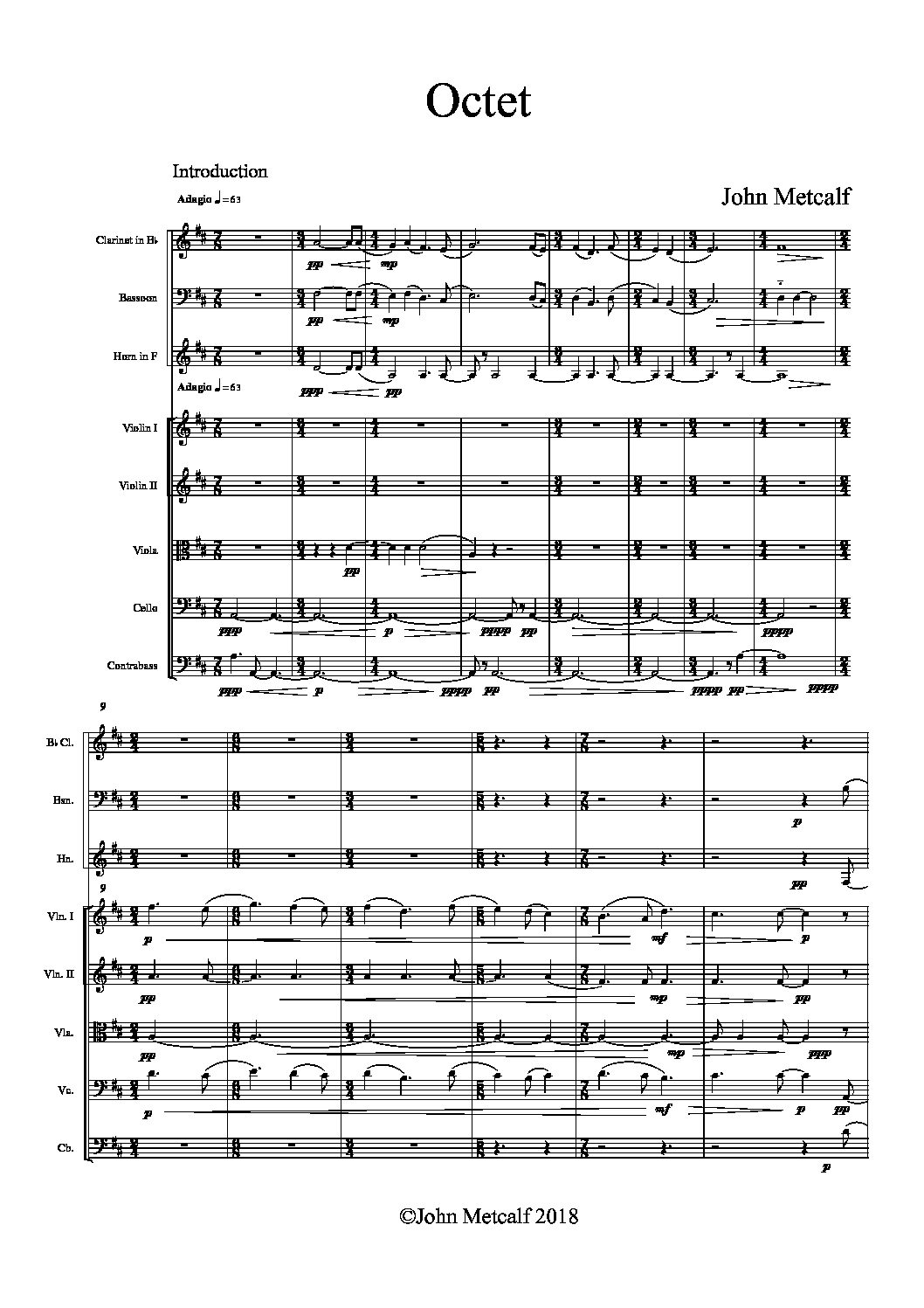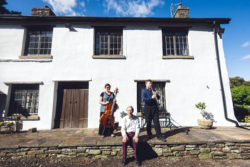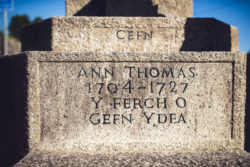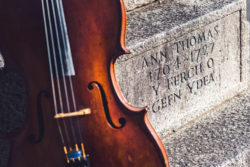Programme Note
In November 2014 I started work on some Welsh folk song settings. The originals are, of course, very expressive and characterful none more so than the almost heartbreakingly beautiful Bugeilio’r Gwenith Gwyn. After setting it I immediately made sketches for further development of and variations on the song and shortly after wrote the piano piece CHANT based on it. When, in 2017, Peryn Clement Evan asked me to write an Octet for Ensemble Cymru I knew at once which ideas and sketches I wanted to develop.
The combination of instruments for which Schubert wrote his monumental Octet – Clarinet, Horn, Bassoon and String Quintet(with Double Bass) – is both sonorous and sombre and gives full rein to the singing qualities of his music. Wales is also renowned for its singing and the instrumentation is a real gift, perhaps particularly for a Welsh composer. The singing that I have referenced here is hymn singing and I have accentuated that choice by the use of a pedal note A throughout the entire piece.
In composing the work I was conscious too of the well-known jibe that the only thing to do after playing a folk-song was to play it again louder. In an attempt to belie this and in the search for a musical experience that would develop and evolve during the playing time I took as my starting point the fact that this beautiful song commemorates the fate of star-crossed lovers – Ann Maddocks and Wil Hopcyn. How often does beautiful music provide a backdrop to violence against women!
While not following this tragic love story sequentially I have tried to reflect both its highs and lows and these find their further expression in the deliberate use of opposites in the work, male and female, question and answer, major and minor modalities. At times the (male) wind instruments counterpoint the (female) string instruments, each group acting in the manner of subliminal alter egos. The folk song arrangement is placed at the end of the piece in an attempt to contextualise it within the continuity of human experience in our age-old country. There are seven sections to this 20’ work – Introduction: Variation I: Variation II: Variation III: Variation IV: Variation V: Theme.
Finally, I wish to record my grateful thanks to Ensemble Cymru for commissioning such an ambitious work at a time of great financial stringency in the arts in Wales.
Note by the composer
Welsh Version
Ym mis Tachwedd 2014 dechreuais weithio ar osodiadau o ganeuon gwerin Cymraeg. Mae’r gwreiddiol, wrth gwrs, yn fynegiannol ac yn llawn cymeriad, yn enwedig yr alaw dor-calonnus brydferch, Bugeilio’r Gwenith Gwyn. Wedi i mi ei gosod, mi es ati’n syth i wneud brasluniau ar gyfer datblygiadau pellach ar amrywiadau ar y gân ac yn fuan wedyn cyfansoddais y darn CHANT, a gafodd ei seilio arno. Pan ofynnodd Peryn Clement-Evans i mi llynedd i gyfansoddi Wythawd ar gyfer Ensemble Cymru, gwyddwn ar unwaith pa syniadau a brasluniau roeddwn i’n dymuno eu datblygu.
Mae’r cyfuniad o offerynnau y cyfansoddodd Schubert ei Wythawd anferthol ar eu cyfer – Clarinet, Corn, Basŵn a Phedwarawd Llinynnol (gyda Bas Dwbl) – yn soniarus ac eto’n ddigalon ac yn rhoi rhywydd hynt i rinweddau melodaidd ei gerddoriaeth. Mae Cymru hefyd yn enwog am ei chanu ac mae’r offeryniaeth yn wir rodd, yn arbennig i gyfansoddwr Cymreig efallai. Y canu y cyfeiriaf ato yma yw canu emynau ac rwyf wedi pwysleisio’r dewis hwnnw drwy ddefnyddio’r nodyn pedal A drwy’r holl ddarn.
Wrth gyfansoddi’r gwaith, roeddwn hefyd yn ymwybodol o’r cellwair adnabyddus mai’r unig beth i’w wneud ar ôl canu cân werin oedd ei chanu eto’n uwch. Mewn ymgais i wrth-ddweud hyn,ac wrth chwilio am brofiad cerddorol a fyddai’n datblygu ac yn esblygu yn ystod y chwarae, fy man cychwyn oedd y ffaith fod y gân brydferch hon yn coffáu tynged cariadon anlwcus Ann Maddocks a Wil Hopcyn.
Er nad ydwyf wedi dilyn y stori garu drasig hon yn gaeth, ceisiais adlewyrchu ei huchafbwyntiau a’i hisafbwyntiau, ac fe gaiff rhain eu mynegi ymhellach wrth wneud defnydd bwriadol o wrthgyferbyniadau yn y gwaith, gwryw a benyw, cwestiwn ac ateb, cyweiriau mwyaf a lleddf.
Ar adegau mae’r offerynnau chwyth (gwrywaidd) yn gwrthbwyntio’r offerynnau llinynnol (benywaidd), a phob grŵp yn ymddwyn fel eu alter egos cudd. Gosodwyd trefniant yr alaw werin ar ddiwedd y darn mewn ymgais i roi cyd-destun iddo o fewn parhad profiad dynol ein gwlad hynafol. Mae saith adran i’r gwaith 20 munud hwn – Cyflwyniad: Amrywiad I: Amrywiad II: Amrywiad III: Amrywiad IV: Amrywiad V: Thema.
Yn olaf, hoffwn nodi fy niolch i Ensemble Cymru am gomisiynu gwaith mor uchelgeisiol ar adeg o gryn lymder ariannol yn y celfyddydau yng Nghymru.




